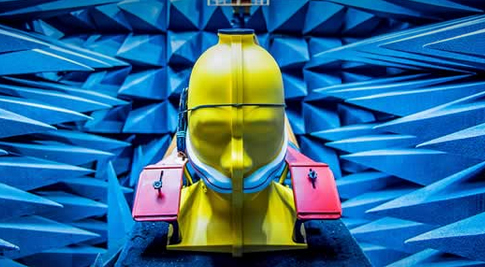Specific Absorption Rate (SAR) Lab
Overview
The cornerstone of Wireless Institute’s Specific Absorption Rate (SAR) Lab is the cSAR3D Measurement System manufactured by SPEAG. cSAR3D is the most advanced vector array system for conducting fast, high-precision SAR (Specific Absorption Rate) measurements of wireless devices for testing compliance with national and international safety guidelines. The system is compliant with the IEC 62209-3 and with all fast SAR protocols. The user-friendly cSAR3D system is equipped with superior and powerful technology including a unique vector array, advanced 3D reconstruction algorithms using amplitude and phase information, state-of-the-art fast data acquisition, and tight integration of base station simulators.
The SAR Lab’s cSAR3D System includes a flat phantom for body-worn measurements and the right side of the SAM head phantom. The head phantoms are filled with a head compatible with the dielectric parameters specified in IEC 62209-1 and IEEE 1528-2013 within a ±10% tolerance over a 500MHz–6GHz frequency range. cSAR3D is ideal for conducting SAR measurements where high speed and high accuracy are required such as: SAR compliance evaluation of wireless devices, fast SAR testing, and investigation of the influence of design modifications on RF performance. The visualization features provide a full 3D SAR distribution in the phantom as well as visualization of peak spatial-average SAR for all device configurations. Cameras are integrated into the cSAR3D hardware so that the wireless device location is referenced to the SAR distribution. It has several validation sources for compliance testing between 300MHz–6 GHz.

Full SAM Head
Besides the half head, the SAR Lab includes a full SAM Head which is a lightweight homogeneous anthropomorphic head phantom filled with a broadband head tissue simulating gel for OTA evaluation and optimization of mobile phone devices. The full head is used for the assessment of radiation patterns or total radiated power of mobile phone devices in talk mode in combination with a hand phantom or in head only mode.
RF Anechoic Chamber
The SAR Lab also includes an RF Anechoic Chamber, where the external signals are sealed out and the internal reflections of electromagnetic waves are absorbed completely. This chamber is used to test the long-range performance of the newly constructed, multi-transmitter phones.
Projects
The SAR Lab has been instrumental for the ‘Improved Phone Design for SAR constraints’ project, with its related publications and conference papers.

